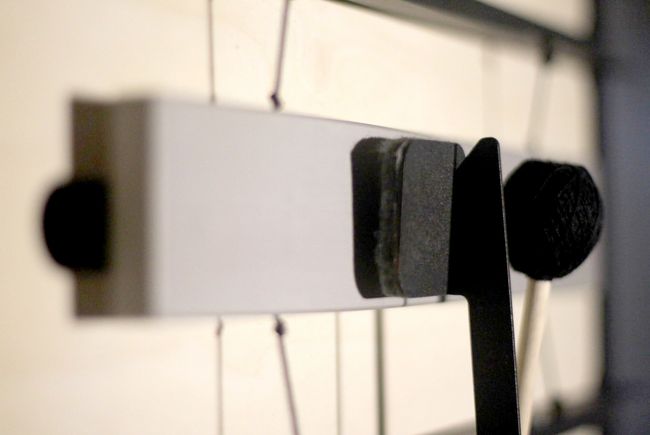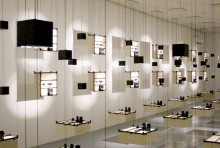In solfeggio classes a lot of time is dedicated to the study of musical intervals. The fifth, for instance, spans five semitones. A perfect fifth, between C flat and G flat, contains three and a half tones and is considered to be a harmonious interval. Take G sharp instead of G flat, and you get a sharp, alarming sound. This is the diminished fifth, or the tritone (spanning three tones, respectively). So in music spontaneous art is closely intertwined with math.
The so-called generative music is based on algorithms. The Vilnius branch of Ukrainian art gallery TSEKH recently hosted a kinetic generative art installation. Lithuanian artist Andrius Sarapovas has developed an object based on a special algorithm, which enables to transform one second of viewing the levels of 4G coverage into one second of music. The number of internet connections in various regions of Lithuania defines the rhythm and sound volume. The amount of downloaded information affects the pitch. Session statistics also affect the brightness of light and speed of shadow animation.
PRECISE DATA AND ABSTRACTION
The installation consists of 77 segments. Each includes a metal plank, sound activator, sound damper, a resonator, and a mechatronic device. The segments are placed in such a way as to create 4 narrow and 11 broad flows in the exhibit room. In his work on the installation, Sarapovas was assisted by a team of more than 70 programmers, engineers, electrical mechanics, and other experts. The preparations lasted some five months.

THE SOUNDS OF STATISTICS! THIS KINETIC INSTALLATION CONSISTS OF 77 SEGMENTS. EACH CONTAINS A METAL PLANK, A SOUND ACTIVATOR, A SOUND DAMPER, A RESONATOR, AND A MECHATRONIC DEVICE, WHICH WRITES PROGRAMS FOR THE MECHANISMS WHICH CONTROL THE EQUIPMENT. IN THE PHOTO: COMPONENTS OF ONE OF THE SEGMENTS
In the author’s concept, virtual two-dimensional information acquires the features of a real object. “That is why I used music as a means of expression: this is the spatial and the abstract that stands in sharp contrast to the flat precision of statistics,” explains Sarapovas.
The structure of the object is largely defined by the space in which it is placed. In this case, the object was created in order to fit the dimensions and acoustics of TSEKH gallery. But the artist knew from the very start that the installation will be composed of segments. “It all happened very organically. It was not from the very start that I had a final vision of my project. At first, I found answers to my original, rather abstract, questions. Then various factors affected the solutions which were found in the course of working on the project,” shares Sarapovas.
“AS IF INSIDE A MUSIC BOX”
Sarapovas, who lives and works in Vilnius, over the recent 18 years has been working in the genre of electro-acoustic music, dramatized performances, and videos. “I had flirted with kinetic art before, but this is my first project of such a scale,” explains Sarapovas. “I am fascinated by a statistical record of actions taken by a multitude of people, as a form of chaos and noise. I have a good friend, a physicist, who has worked for some time on noise. He explained to me certain aspects of this phenomenon. I am interested in various forms of order and noise, as well as in randomization, i.e. random selection.”
“The project is a suggestion made by a Vilnius-based production studio SomeFilms. The artist himself chose our gallery, and later he sent a substantiation which stated that this installation is an original work,” tells Oleksandr Shchelushchenko, founder of TSEKH Gallery. “This is extremely hard work, with 200 objects which generate sound, the space is not quite usual, and neither is the reality in which you find yourself. My first impressions of the installation were such as if I found myself inside a Buddhist stupa filled with some other-worldly music. You could compare this with sitting inside a music box of some sort.”

“PEOPLE ARE SHAPED BY INFORMATION FLOWS”
“Such music shows that man’s chaotic activity could be transformed into a harmony,” Sarapovas muses. “In a broader sense, we ourselves are machines collecting statistical data. Using short- and long-term memory, the memory of our body and senses, we are constantly collecting and absorbing information. We are shaped by information flows. On the one hand, numbers help simplify and mark data, on the other, they can lead to abstraction. The notion of infinity comes to us via numbers, thus limitation or simplification are quite conventional, when applied to them. Numbers can be extremely expansive.”
The author of the installation confesses being one of those people who structurize everything they do. “When it comes to numbers, some solutions can have an inner, symbolic meaning for me, but it is my own sandbox,” continued Sarapovas. “I can see much and I can refrain from conscious self-restriction. Structurizing actually gives you freedom. When you can do anything you will, you never do nothing. When you have a set of rules, you are free within their limits. Here I do not see any conflict. Maybe it is just the way my mind works, but I need clear-cut definitions. And this is a gift because it forces me to be resourceful.”







